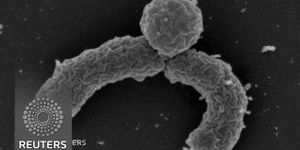
Health professionals have long known the effects of stress on the human body. Stress can cause cardiac problems, high blood pressure and chronic pain in addition to the effects on the nervous system and mental health conditions. While there have always been indications that stress-related illnesses get passed down from generation to generation, the actual neurological pathways for this have remained difficult to document.
One theory is that the epigenome, the collection of chemical modifications to a cell's protein and DNA, carries imprinted information about external stressors. Exactly how and when these external stress factors start to change the chemical make up of the epigenome is object of several studies, the most recent by a group of researchers at the Friedrich Miescher Institute for Biomedical Research (FMI)
To investigate how the environment can influence epigenetic processes, FMI Senior group leader Marc Bühler and his group conducted experiments with fission yeast. In a paper published in Cell Reports, they detailed their findings about the identification of a regulatory circuit that buffers a potentially harmful epigenetic switch under stressful conditions. The capacity to prevent such an epigenetic change is important to the organism, perhaps because the altered epigenetic state is maintained for many cell divisions, well after the stress has subsided.
For a unicellular organism such as fission yeast, the best external factor for observing a stress response is heat. An important protein in fission yeast is Dicer. Under normal conditions it is located in the cell nucleus and prevents stress response genes from being activated.
When the yeast was exposed to high temperatures, the protein left the nucleus and accumulated in the cytoplasm. This allowed for the expression of the stress response genes. Thus, by moving out of the nucleus, Dicer enables full activation of the yeast's stress response.
In their study, Bühler and colleagues used correlative light and electron microscopy (CLEM) to show that Dicer accumulates as an aggregate in a novel cytoplasmic compartment during heat stress. Once there Dicer is joined by the well-known protein disaggregase Hsp104, which dissolves the Dicer aggregates. Dicer then recycles back to the nucleus.
"What is particularly intriguing is that Hsp104 is one of the "stress genes" that is repressed by Dicer in the nucleus. Hsp104 thus guarantees that Dicer can again take on its nuclear functions, one of them being the repression of "stress genes" like HSP104. Thus we are dealing a with classical negative feedback loop", explains Bühler.
Dicer has another important function. It ensures the stability of the yeast genome by maintaining the dense amounts of heterochromatin. Without heterochromatin, chromosomes segregate improperly during mitosis. This can result in an uneven number of chromosomes, either too many or too few, as well as chromosome instability both of which are hallmarks of many forms of cancer. In their paper, Bühler's team was able to show that in the absence of Hsp104, Dicer remains in the cytoplasm and heterochromatic regions on the yeast genome are no longer stable after exposure to heat stress. This leads to changes in gene expression and even worse, chromosomal missegregation during cell division.
"The observed changes in heterochromatin and gene expression incurred after a stressful situation in the absence of functional Hsp104, are still present long after the stress has subsided," comments Bühler. "What we have here is a phenomenon that complies with the classic definition of epigenetics: an event where an environmental cue triggers a change in gene expression that does not entail a change in the genomic sequence, yet which is inherited for many cell divisions, even after the environmental cue has disappeared."
 Health professionals have long known the effects of stress on the human body. Stress can cause cardiac problems, high blood pressure and chronic pain in addition to the effects on the nervous system and mental health conditions. While there have always been indications that stress-related illnesses get passed down from generation to generation, the actual neurological pathways for this have remained difficult to document.
Health professionals have long known the effects of stress on the human body. Stress can cause cardiac problems, high blood pressure and chronic pain in addition to the effects on the nervous system and mental health conditions. While there have always been indications that stress-related illnesses get passed down from generation to generation, the actual neurological pathways for this have remained difficult to document.







